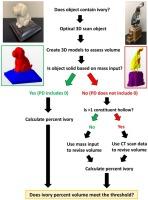Determination of the volumetric percentage of ivory content using 3D modeling: Assessment of composite objects and threshold exemption status
Abstract
Measurement of the percentage volume of the ivory constituent of a composite object is necessary to ensure compliance with the ivory volume provision in California Fish and Game Code (FGC) section 2022. Assessment of the ivory percentage must be conducted as a percentage of the total volume of the composite object and be of a non-destructive nature. To meet these analytical requirements, optical three-dimensional (3D) scanning and imaging software algorithms were used to create 3D models of three composite objects and to measure the volumetric percentage of the ivory constituents. Volumetric percentage determination of the ivory constituents was conducted on the composite objects in both the assembled and the disassembled states to assess the percentage error (PE) for ivory volume measurements when destruction of an item is not permitted. For objects or carvings with clearly defined boundary lines, a PE of <5% is recommended to be added to the volumetric ivory findings to factor in the presence of hidden, non-visible ivory. For an object without clearly defined boundary lines between ivory constituents and adjacent non-ivory constituents, the PE was dependent on the size, type, and number of ivory interfaces. The validity of the optical 3D scanner was assessed using a reference object of known geometry and shown to be accurate within a PE of ±0.3%. The findings of this study suggest that the volumetric percentage of ivory for a composite object can be accurately determined using a non-destructive optical 3D scanning method.


 求助内容:
求助内容: 应助结果提醒方式:
应助结果提醒方式:


